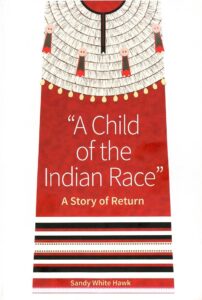Book review: ‘A Child of the Indian Race’: A Story of Return
 Reviewed by Karl Hele
Reviewed by Karl Hele
“A Child of the Indian Race”: A Story of Return is Sandy White Hawk’s compelling, powerful, and spiritual journey as an adoptee seeking, finding, and embracing her Indigeneity. The book is divided into three parts – Truth, Healing, and Reconciliation. Part 1: Truth discusses and describes the story of White Hawk’s journey, growing up as an adoptee, and tentative steps home. Part 2: Healing explores how she gradually moved toward a personal healing, involvement in community, and development of a larger vision seeking to aid in the healing of all those impacted by the removal of children from community and family. Lastly, Part 3: Reconciliation looks at how to effect change in organizations, deal with the colonial system, and teach agents of the system. She also discusses the importance of healing everyone involved in apprehension process, particularly individuals, family, and community, while trying to establish a pathway forward to heal the pain. Each section brings with it reading challenges, as White Hawk very openly discusses her trials, abuse, healing, and the impact of everything on her emotionally, physically, and mentally. In the end, she does bring herself healing and seeks to help others on their journey to healing through balance.
White Hawk begins her truth, at the start of her journey, not with her adoption, but after leaving her husband in 1988 and receiving a phone call from a rape crisis centre. After attending her assessment appointment, White Hawk joined a 10-week support group that encouraged her to reconnect with family in Rosebud. This initial encouragement led to a series of emotional and spiritual events that ultimately healed and changed White Hawk. By openly sharing her experiences of growing up, healing, growing, and creating a path for individual, family, and community healing, the book is often difficult to read. Her uncertainty, awkwardness, and fears as she reconnects with home, often driven by her loss of connection as an adoptee and childhood trauma, regularly need to be overcome. Thankfully, White Hawk meets and works with a wonderful Elder named Chris.
For me, the most powerful and inspiring section of the book is when White Hawk has a vision that directs her to create a healing process for everyone impacted by the removal of children. To this end, White Hawk and Chris created the Wablenica Ceremony–the Orphan Ceremony to help heal the grief caused by the removal of children from family and community. The work ends with White Hawk’s call to stop removing children from families and communities. Overall, her narrative is an incredibly emotional, straight forward, and direct accounting of the life, work, and experiences of an adoptee. It is not an ‘easy’ read.
While White Hawk’s personal narrative is born of the American experience, it has multiple parallels with the impact of the Canadian Sixties Scoop on First Nations individuals, families, and communities. Similar to White Hawk, First Nations children were fostered or adopted into non-Indigenous families where many experienced physical abuse, discrimination, racism, and cultural dislocation. Moreover, they faced hurdles in developing a strong sense of identity while continuing to face varying levels of emotional and mental health challenges due to experiences within the Child Welfare System. Like White Hawk, many adoptees are finding their way home, reuniting with family and community, and healing.
Finally, while First Nations in Canada and the US have gained greater control over Child Welfare policies, Indigenous children continue to be over represented in care. Yet, White Hawk’s story illustrates that there is hope for a more just system and a restoring our nations through a healing of individuals, family, and community. The journey will not be simple nor easy – it will require dedication, passion, and a lot of work. It is a journey that we must take.
I highly recommend White Hawk’s A Child of the Indian Race for anyone interested in learning about child apprehensions in the United States as well as how one person undertook a journey toward healing. It is a powerful evocative read that some will find triggering and perhaps traumatizing; however, if possible, the work needs to be read!
Sandy White Hawk, “A Child of the Indian Race”: A Story of Return. St. Paul: University of Minnesota Press, 2022.
ISBN: 1681342413


